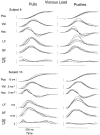The role of internal models in motion planning and control: evidence from grip force adjustments during movements of hand-held loads
- PMID: 9006993
- PMCID: PMC6793733
- DOI: 10.1523/JNEUROSCI.17-04-01519.1997
The role of internal models in motion planning and control: evidence from grip force adjustments during movements of hand-held loads
Abstract
We investigated the issue of whether or not the CNS makes use of an internal model of the motor apparatus in planning and controlling arm movements. In particular, we tested the ability of subjects to predict different hand-held loads by examining grip force adjustments used to stabilize the load in the hand during arm movements. Subjects grasped a manipulandum using a precision grip with the tips of the thumb and index finger on either side. The grip force (normal to the contact surfaces) and the load force (tangential to the surfaces) were measured, along with the trajectory of the hand. The manipulandum was attached to two servo-controlled linear motors used to create inertial and viscous loads as well as a composite load, including inertial, viscous, and elastic components. The form of the hand trajectory was independent of load for some subjects but varied systematically across load conditions in others. Nevertheless, under all load conditions and in all subjects, grip force was modulated in parallel with, and thus anticipated, fluctuations in load force despite the marked variation in the form of the load function. This indicates that the CNS is able to predict the load force and the kinematics of hand movement on which the load depends. We suggest this prediction is based on an internal model of the motor apparatus and external load and is used to determine the grip forces required to stabilize the load.
Figures






References
-
- Atkeson CG. Learning arm kinematics and dynamics. Annu Rev Neurosci. 1989;12:157–183. - PubMed
-
- Belen′kii VE, Gurfinkel VS, Pal′tsev EI. On the elements of control of voluntary movement. Biofizika. 1967;12:135–141. - PubMed
-
- Bouisset S, Zattara M. Biomechanical study of the programming of anticipatory postural adjustments associated with voluntary movement. J Biomech. 1987;20:735–742. - PubMed
Publication types
MeSH terms
Grants and funding
LinkOut - more resources
Full Text Sources
Other Literature Sources
